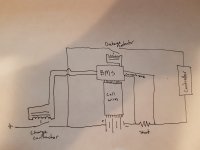flippy said:
No, and then even more no.
the BMS is NOT a part of the charger, it is a PROTECTION system that does nothing until things go out of spec. that means it will trigger only when damage is already happening.
it is the job of the charger to stay within the spec of the battery you are connecting it to. a charger is NOT a power supply. a power supply only has CV, a charger has CC and CV.
what will happen is that you charger (if set too high) will contine to charge above 4.2V and eventually around 4.25 it will trigger the BMS to cut power. after a few seconds the voltage has dropped and the BMS releases again putting full power of the charger into the battery again wich will trigger the BMS again after a few seconds. this hiccup behaviour will repeat constantly until you have killed your pack.
First off, I know the difference between a power supply and a charger, and it isn't just one has CV and one has CV and CC. I have a 2 bench top power supplies, 60V/10A, sitting not 15ft from me. They are both CV and CC. They are not chargers, are they? Of course not.
I have been looking at adjustable power supplies for my build that have both adjustable voltage regulation and adjustable current regulation, aka CV and CC. They are not chargers. The Meanwell PSUs that amberwolf suggested, they have CV and CC, they are not chargers.
That said, the BMS is a part of my charging setup. You can set it up so that it cuts power at 3.9V if you wanted. So I'm not sure what you are on about, since I
clearly stated that the OCP would be set at 4.1V
The current tapering, and knowing the battery is fully charged is what makes a charger a charger. It is what sets my BMS apart. I can manually set current limits, but it doesn't happen automatically, so no tapering happens. It will only know that the battery is fully charged when the battery sits between OCP and OCR, but inevitably the battery will drop past OCR. Not sure how long that would take, depending on the settings (say 4.1V and 3.8V).
Giving the battery full current (say 0.5C or 1C) for the entire length of the charge, according to BU, wouldn't kill the battery. It would cause stress, lower the amount of full charge, and diminish the number of cycles though. It's called a full saturation charge. It's what a lot of people seem to do here, when they use just a PSU like a meanwell with adjustable voltage and current.
flippy said:
also: you cant use the battery in this condition. it;s impossibe to drain without bypassing the BMS.
Sorry, I'm not sure what you mean by "in this condition"?
flippy said:
no, there is no BMS on the market that can balance while discharging.
The manual states that this BMS can, but I presume it simply means during discharge "mode", when the charge contactor is open, and the discharge contactor is closed.
flippy said:
dont be dumb and take the hint of half a dozen people here and do it proper.
You mean like using an adjustable voltage and adjustable current power supply? A meanwell PSU? That proper? It's still not a charger.


